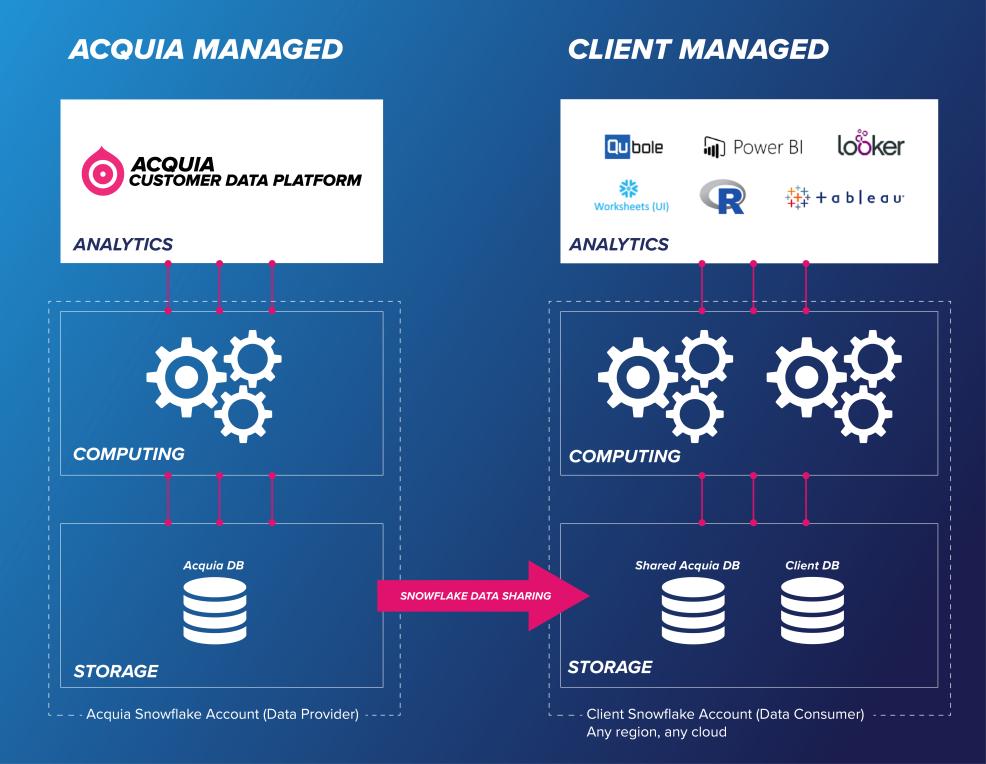Unlock the Potential of Cleansed, Enriched Data with Acquia CDP and Snowflake Secure Data Sharing

Companies today are collecting more data than ever before to create engaging customer experiences. Yet as the quantity of data grows, many struggle to transform that data into insights and actions that produce meaningful results. Data sharing allows deeper integration of data from a customer data platform (CDP) such as Acquia CDP into organizational processes. If the barrier to gain access to clean, processed, current data goes down significantly, each member of your team can be empowered to make data-driven decisions on a daily basis.
Acquia CDP has a strategic partnership with Snowflake, the industry-leading data warehouse that powers our CDP’s analytics applications such as Metrics and Interactive Queries. The joint solution provides reporting and full SQL access to processed, record-level data within Acquia CDP with fast query performance via Snowflake. Marketing, IT, and data science teams can thus take advantage of vast amounts of omnichannel customer data enhanced with Acquia CDP’s online-offline identity resolution and predictive analytics.
This collaboration takes our Interactive Queries offering a step further by allowing teams to truly unlock the potential of their cleansed, processed data within Acquia CDP via Snowflake Secure Data Sharing. As part of this new offering, data is instantly shared from Acquia CDP’s Snowflake account (data-provider) into your Snowflake account (data-consumer). With Secure Data Sharing, data doesn’t move, eliminating the cost, headache, and delays associated with legacy data sharing methods that deliver only slices of stale data. Instead, data is immediately available for use in your Snowflake account – no transformation, data movement, loading, or reconstruction required.
Key use cases and advantages of CDP data sharing
Here are a few examples of how data sharing can be used to drive better business value when combined with the powerful foundation of a CDP.

- Use your favorite BI and analytics platform: It’s a crowded space for business intelligence (BI) tools and analytics platforms. Some are more advanced than others, and your team may already have a favorite. Acquia CDP’s Metrics is built on Google’s Looker, an industry-leading analytics platform, and empowers marketers to build customizable dashboards and access customer insights instantly. But picking Acquia CDP as your CDP doesn't mean you have to give up your pre-existing tools and processes for analyzing data. With data sharing, you get full Java database connectivity (JDBC) or open database connectivity (ODBC) to Acquia CDP’s shared database along with a host of other interfaces in Snowflake’s vast ecosystem. Feel free to check them out in Snowflake's documentation. (Hint: it’s quite extensive, and you'll likely find an out-of-the-box connector for your favorite platform.)
- Analyze Acquia CDP’s data with external non-CDP data: Data is everywhere, but a CDP may not have all operational data such as financial forecasts, supply chain and inventory management, and so on for your business. Oftentimes, marrying transactional data from a CDP to operational data leads to insightful results, which is much easier when all your data is available in the same data warehouse. With data sharing and Snowflake’s unique architecture, you can join across multiple databases (including Acquia CDP’s shared database) in the same query or report.
- Build on top of Acquia CDP’s data: The possibilities for what you can do with Acquia CDP’s data are endless, but building your own machine learning (ML) models is one application of Acquia CDP’s data. You may already have a stellar data science team – if not, data sharing will allow you to build one! The success of any ML project depends on your access to clean data as soon as it’s available. With Acquia CDP constantly enriching your data and data sharing making it available instantaneously in your Snowflake account, you don’t need to depend on your IT team to manage a complex extract, transform, and load (ETL) process. Your team can thus run experiments and build models more efficiently by leveraging Acquia CDP's data. You could even feed the results of your ML models back to Acquia CDP for use in Actions and 360° Profiles.
Don't want to build models in house? Acquia CDP also includes Machine Learning Studio, which lets you create custom models directly on the platform and feed them into the CDP to generate meaningful insights that drive your digital initiatives.
For more information on how a CDP can help you collect, unify, and activate your customer data, check out our e-book.
This blog was originally published in 2023 and has been updated to remain current.



